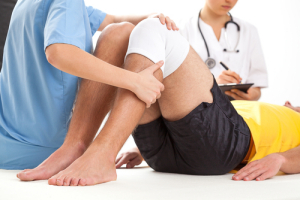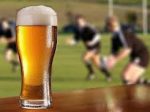 Stress fractures are usually associated with athletes and overtraining.
Stress fractures are usually associated with athletes and overtraining.
However they can affect anybody as besides exercise stress, bone strength is determined by age, lifestyle and nutrition choices.
Find out if you at risk and how to prevent stress fractures from spoiling your plans to keep fit and mobile.
What are stress fractures?
Stress fractures are painful weaknesses and hair-line cracks in bone caused by repetitive stress and are responsible for an estimated 10% of all sports overuse injuries. They are common in lower extremities, the shin, foot and ankle and can also occur in the back and arms. Symptoms can include dull pain around the site of the fracture and swelling which worsens with exercise, walking or standing. In severe cases they can lead to long-term bone malformations. 1
Overtraining is the main cause of stress fractures as well as sudden changes in the intensity, duration and frequency of exercise programs. When this occurs bone is weakened leaving little time for repair. As running and jogging involve ground reaction forces that are 3-8 times greater than walking, distance runners and track athletes are particularly prone to developing stress fractures. 2
Stress fractures can also occur due to depressed remodelling of bone as a result of malnutrition, hormonal change, metabolic disease and osteoporosis 1
Diagnosis
Normal x-rays can miss these fine fractures however they can be picked up by MRI and nuclear bone scans and other imaging techniques.
Treatment
Elevation of the affected area and rest is initially the best treatment with the application of ice for 24-48hrs and pain relief. Full recovery can take months or years and in extreme cases surgery may be required. Reducing the activity that led to the fracture for 6-8 weeks is usually advised although it may not be necessary to stop exercising altogether with swimming or cycling often a safer way of maintaining fitness.1
Prevention is better than cure
As bone is a dynamic structure that is constantly changing it can easily be affected by changes in health, lifestyle or nutrition choices. Understanding how to grow, strengthen and preserve bone health is important to our mobility and freedom throughout life.
Osteoblasts are the cells that build up bone while osteoclasts slow the bone building process. This bone remodelling goes on all the time and helps to prevent the excessive calcification of soft tissue. The whole process is regulated by hormones such as growth hormone, insulin, parathyroid, testosterone and oestrogen.
Peak bone mass is generally reached by 18-20yrs and then declines with age, particularly for women following menopause when oestrogen levels fall. Any interruption in peak bone building during the adolescent years (e.g. due to malnutrition or eating disorders) can result in severely compromised bone density in later life. Good nutrition is the key-lifelong.
Bone building
While there are a number of micronutrients that help bone building, the most essential are:
Protein (collagen)
This is formed by eating foods such as meat, fish, soy, eggs, milk products, beans and peas. Two servings of these types of foods are recommended per day.
Vitamin C
Helps collagen formation and eating just 2 pieces of fruit and 3 servings of vegetables (the size of your clenched fist) can provide the 30-40mg of Vitamin C required by most of us each day.
Calcium
Is found in milk, cheese, yoghurt, canned fish (+bones) dried dark fruits and broccoli provides this mineral important for bone formation. Requirements are age dependent but adults generally require 1000-1300mgs/day. This can be achieved by having 2 servings of calcium rich food/day. (e.g one serving could be 250mls milk; 2x150g pottles of yoghurt, 2 slices of cheese)
Vitamin D
Essential for bone formation Vitamin D aids the absorption of calcium. Just half an hour of sunlight on your face each day is usually sufficient to meet the body’s needs. Vitamin D is also found in fatty fish (sardines, tuna, salmon) margarines, eggs, beef and lambs liver.
Energy levels
Are an important consideration because it takes a lot of energy to build bone. When intake is less, than the energy expended through exercise, body maintenance and repair will suffer.
Bone loss
A number of factors can conspire to speed bone loss
Excess weight loss
Intentional weight loss to achieve and maintain a healthy BMI (Body mass index) throughout life can benefit bone health if the diet is adequate and well-balanced. However this is not always the case:
- Un- intentional weight loss can occur as people age. As muscle mass is lost it becomes more difficult for people to prevent falls and as bones becomes weaker they are more prone to fracture.
- Post- menopausal women need to take particular care when trying to remain “slim” and “fit” as they age as they can be just as at risk as younger athletes of developing eating disorders causing bone loss if their BMI drops below a healthy range
- Athletes trying to “make weight” in sports where body weight is a condition of entry, e.g. rowing, gymnastics, ballet, wrestling and equestrian, are also at risk. This can be the case particularly for developing athletes who are also trying to attain their peak bone mass.
- The Female Triad is a term used to describe a harmful chain of events which can occur when a woman’s body weight drops below her healthy BMI threshold. This can trigger a fall in oestrogen levels causing amenorrhea (loss of monthly periods) and decline in bone mineral density (BMD) causing osteoporosis. This can greatly hamper the performance aspirations of young elite athletes committed to rigorous training schedules.
Excess alcohol intake
It is hard to separate alcohol from sport as historically it has been used to celebrate a “win” or drown the pain of a “loss”. Alcohol intake is also increasingly a part of our social culture affecting young and old alike. However if taken in excess it can be detrimental to bone health.
Defining “excessive intake” is difficult as tolerance varies according to factors such as gender and body weight. A “heavy drinker”is now defined for men as someone consuming >4 standard drinks/day( > 3/day for women) or more than 14 standard drinks per week for men (more than 7 per week for women). 4
In excess alcohol sets in motion a chain of events that weaken bone:
- Hormonal change
– Parathyroid hormone rises with alcohol intake releasing calcium and phosphorus from the bones into the blood stream reducing bone strength.
– Cortisol also responds to excess alcohol in the blood by reducing bone formation
– Sex hormones testosterone and oestrogen levels also fall reducing bone formation and accelerating bone loss. 4,5 - Liver Function Alcohol interferes with the liver enzymes that regulate Vitamin D metabolism resulting in reduced calcium absorption from the gastrointestinal tract.
- Pancreas Function Alcohol, in excess, can damage the pancreas affecting the secretion of some of the enzymes that aid the digestion of food and absorption of nutrients important for bone health such as Vitamin D, Calcium, Vitamin C and other nutrients.
- Low energy intake Poor nutrition can accompany excessive drinking behaviour. As fruit and vegetables intakes decline Vitamin C is lost often in favour of fast foods that can be high in fat, sugar and salt. This may not only weaken bone but can also affect heart health.
Sodium
Athletes may assume that because they lose sodium through sweat losses they can eat more processed foods such as bars, snacks, crisps and sports drinks. However high sodium levels can increase calcium losses through urine and sweat.
Every 500mg of sodium leaches 10mg of calcium from your bones. So read food labels and limit your sodium intake to 2.3g (2300mgs/day) which is around 1 tsp in total. Athletes should discuss their needs with a Sports Dietitian who can help them to get the correct balance of nutrients.
Phosphoric Acid
This cheap food addictive is often used to acidify foods and beverages. It is particularly used in the manufacture of regular and diet cola beverages and is widely believed to reduce BMD.
The Framingham Osteoporosis study 2006, found the mean BMD of those with daily cola intakes was 3.7% lower at the femoral neck and 5.4% lower in the surrounding bone area (Ward’s triangle) than those who consumed < 1 serving of cola per month. Similar results were seen for diet cola and although weaker, decaffeinated colas as well. 6
Wheat bran
While wheat bran is an important source of dietary fibre and good for bowel health it can reduce calcium absorption if taken at the same time.
So if eating bran with milk for breakfast try to have other calcium rich foods such as cheese or yoghurt in your lunch and trim milk smoothies mid-afternoon or after training. If you are taking a calcium supplement do so 2-3 hours before or after you eat your bran.
Sugar
High blood sugar levels can endanger bone health by increasing calcium losses through urinary excretion . While athletes do require high levels of carbohydrate to maintain their energy levels they need to understand how to manage their glycaemic load through correct timing of meals and snacks rather than constantly grazing on sugar laden drinks, biscuits and confectionery.
Health conditions affecting bone health
- Asthma and eczema sufferers have a slightly increased risk of bone fractures and injured joints if they are taking steroid medication which can weaken bone so discuss this with your doctor 7
- Gluten free diets are often associated with lactose intolerance which may reduce milk and therefore calcium intake. Talk to us about lactose free sources of dietary calcium .
- Diabetics have a greater risk of bone loss for the following reasons:
– Increases in blood sugar levels increase calcium losses through urinary excretion.
– Some diabetics exhibit resistance to parathyroid hormones accelerating bone loss.
– Changes in peripheral nerve health are a complication of diabetes which can increase damage to feet and the risk of falls.
– Medication used to control Type 2 diabetes e.g. Thiazolidimedione has been found to increase the fracture rate in post-menopausal women. 8
If you are keen to improve your level of exercise and overall fitness then contact us for a nutritional assessment and online consultation. This can help to ensure that your diet matches your training schedule, energy and nutrient needs to build and maintain a healthy body and strong bones.
References
1 Vogin G Stress fractures who gets them and why? WebMD July18 2001
2.Pepper.M, Akuthola.V, McCarty E. The Pathophysiology of Stress Fractures. Clinic in Sports Med 25.1 (2006) 19-27 Print.
3 A Guide to a Standard Drink in NZ 2014 Hpa http://www.alcohol.org.nz/alcohol-you/whats-standard-drink/guide-standard-drinks
4 Maurel DB, Boisseau N, Benhamou CL, Jaffre C. Alcohol and bone: review of dose effects and mechanisms. Osteoporosis Int. 2012 Jan [cited 2013 Sep 21];23(1):1-16. Abstract available from: http://www.ncbi.nlm.nih.gov/pubmed/21927919
5. Sampson HW Alcohols harmful effects on bone. Alcohol health and research world 22:3. 190-194 1998
6 Tucker.K.L, Cola’s but not other carbonated beverages, are associated with low bone mineral density in older women. The Framingham Osteoporosis Study 1,2,3. Amer. Journal of Clinical Nutrition 2006, 84:4, 936-942.
7 Silverberg. J, Day. D, Eczema tied to bone fracture risk in study. Oct 29 2014 JAMA Dermatology.
8.Brandi. M Bone health and diabetes Medicographia 2010,32,364-369
For more information on related subjects refer to Lea’s articles
Children’s bone growth and gut are linked
Don’t let distorted eating ruin your performance
Osteoporosis the silent disease
Sports nutrition for women
Sugar control is essential to better health
It’s important to monitor children’s salt intake
Healthy diet and menopause
Can you pour a standard drink? see Hot links






Leave a Reply